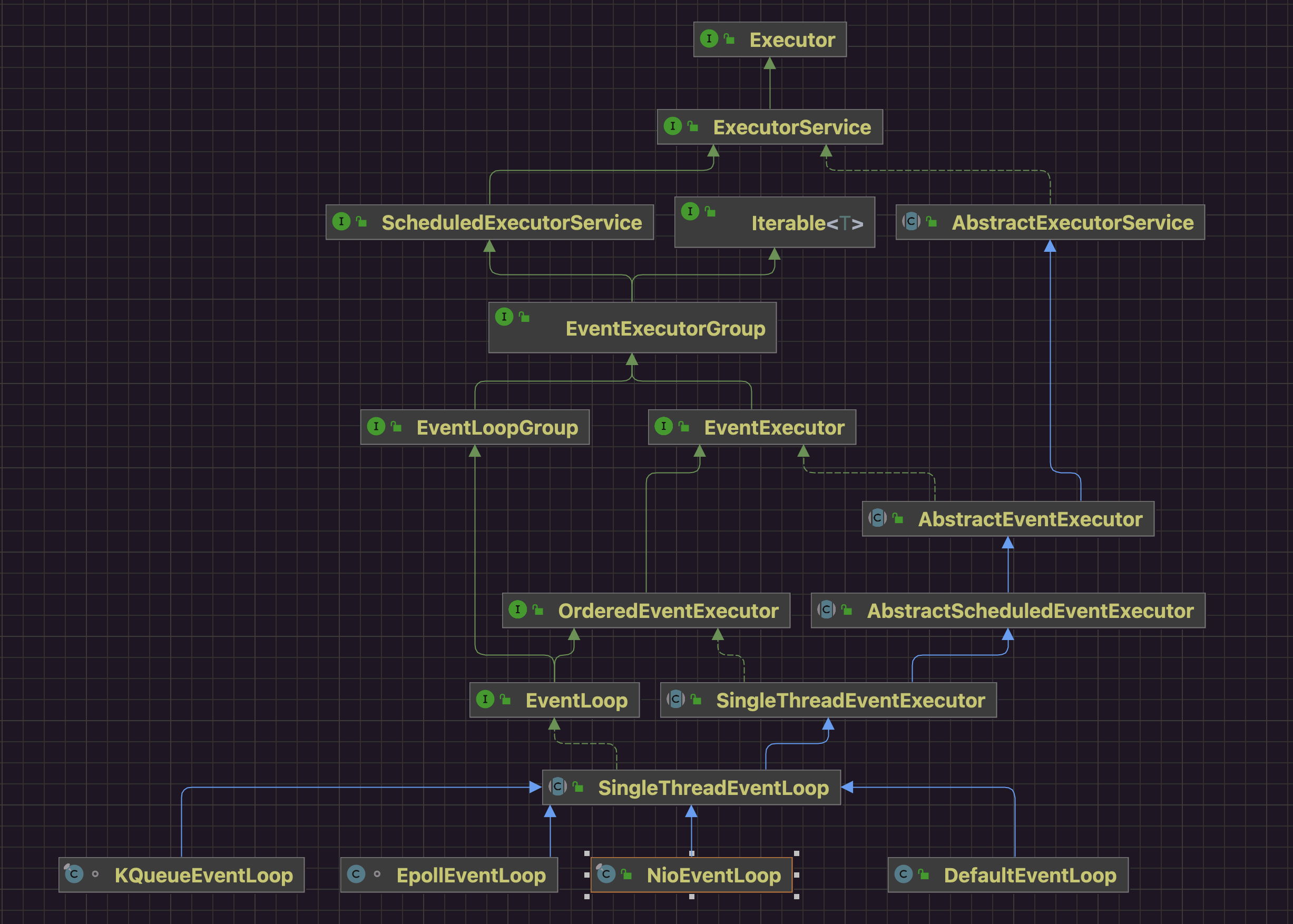前文已经了解过了NioEventLoopGroup 和NioEventLoop 。
在Netty中是用的是Reactor线程模型(IO多路复用器+多个线程),真正处理业务流程的worker线程都是单个线程,一个线程处理多个Channel,一个Channel始终都是由特定的线程进行处理。
在这样的情况下,如果某个Channel的业务流程耗时较久或者阻塞,那么绑定在当前线程上所有的任务都会受到影响,这样的场景如何处理呢?
再看一下EventLoop的继承关系:
从名字就可以看出来EventLoop实现分为两类:
非IO事件循环线程 DefaultEventLoop
IO事件循环线程,在非IO事件循环基础之上增加了对网络IO多路复用器的支持
NioEventLoop 从API上看就是多了register(…)Channel的支持
KQueueEventLoop
EpollEventLoop
…
NioEventLoop的具体实现依赖操作系统
MacOSX -> KQueueEventLoop
Linux -> EPollEventLoop
Windows -> PollEventLoop
一 Demo 将一整条业务流程上比较耗时的部分拆开,使用适当的EventLoop来处理,尽量让每个线程处理的内容都短小,提升处理效率。
1 2 3 4 5 6 7 8 9 10 11 12 13 14 15 16 17 18 19 20 21 22 23 24 25 26 27 28 29 30 31 32 33 34 35 36 37 38 39 40 41 42 43 44 package io.netty.example.basic.eventloop;import io.netty.bootstrap.ServerBootstrap;import io.netty.channel.*;import io.netty.channel.nio.NioEventLoopGroup;import io.netty.channel.socket.SocketChannel;import io.netty.channel.socket.nio.NioServerSocketChannel;public class EventLoopGroupTest01 {public static void main (String[] args) throws InterruptedException {EventLoopGroup bizGroup = new DefaultEventLoopGroup ();new ServerBootstrap ()new NioEventLoopGroup ())new ChannelInitializer <SocketChannel>() {@Override protected void initChannel (SocketChannel ch) throws Exception {"handler1" , new ChannelInboundHandlerAdapter () {@Override public void channelRead (ChannelHandlerContext ctx, Object msg) throws Exception {"handler1" , new ChannelInboundHandlerAdapter () {@Override public void channelRead (ChannelHandlerContext ctx, Object msg) throws Exception {8080 )
二 DefaultEventLoop 1 2 3 4 5 6 7 8 9 10 11 12 13 14 15 16 17 18 package io.netty.example.basic.eventloop;import io.netty.channel.DefaultEventLoopGroup;import io.netty.channel.EventLoopGroup;public class EventLoopGroupTest00 {public static void main (String[] args) {EventLoopGroup group = new DefaultEventLoopGroup ();"execute..." ));
1 DefaultEventLoopGroup构造方法 NioEventLoop的实现是比DefaultEventLoop更丰富的,因此跟踪DefaultEventLoop源码就会简单很多。
1 2 3 4 public DefaultEventLoopGroup () {this (0 );
1 2 3 public DefaultEventLoopGroup (int nThreads) {this (nThreads, (ThreadFactory) null );
1 2 3 public DefaultEventLoopGroup (int nThreads, ThreadFactory threadFactory) {super (nThreads, threadFactory);
1 2 3 4 protected MultithreadEventLoopGroup (int nThreads, ThreadFactory threadFactory, Object... args) {super (nThreads == 0 ? DEFAULT_EVENT_LOOP_THREADS : nThreads, threadFactory, args);
1 2 3 4 protected MultithreadEventExecutorGroup (int nThreads, ThreadFactory threadFactory, Object... args) {this (nThreads, threadFactory == null ? null : new ThreadPerTaskExecutor (threadFactory), args);
1 2 3 4 5 6 7 protected MultithreadEventExecutorGroup (int nThreads, Executor executor, // null Object... args // [SelectorProvider SelectStrategyFactory RejectedExecutionHandlers] ) {this (nThreads, executor, DefaultEventExecutorChooserFactory.INSTANCE, args);
1 2 3 4 5 6 7 8 9 10 11 12 13 14 15 16 17 18 19 20 21 22 23 24 25 26 27 28 29 30 31 32 33 34 35 36 37 38 39 40 41 42 43 44 45 46 47 48 49 50 51 52 53 54 55 56 57 58 59 60 61 62 63 64 65 66 67 68 69 70 protected MultithreadEventExecutorGroup (int nThreads, // 标识着group中有几个EventLoop Executor executor, // null EventExecutorChooserFactory chooserFactory, // DefaultEventExecutorChooserFactory.INSTANCE Object... args // [SelectorProvider SelectStrategyFactory RejectedExecutionHandlers] ) {if (executor == null ) new ThreadPerTaskExecutor (this .newDefaultThreadFactory()); this .children = new EventExecutor [nThreads];for (int i = 0 ; i < nThreads; i ++) { boolean success = false ;try {this .newChild(executor, args); true ;catch (Exception e) {throw new IllegalStateException ("failed to create a child event loop" , e);finally {if (!success) {for (int j = 0 ; j < i; j ++) { for (int j = 0 ; j < i; j ++) {EventExecutor e = children[j];try {while (!e.isTerminated()) {catch (InterruptedException interrupted) {break ;this .chooser = chooserFactory.newChooser(children);final FutureListener<Object> terminationListener = new FutureListener <Object>() { @Override public void operationComplete (Future<Object> future) throws Exception {if (terminatedChildren.incrementAndGet() == children.length)null );for (EventExecutor e: children)new LinkedHashSet <EventExecutor>(children.length);
MultithreadEventExecutorGroup是父类,因此整体流程都是一样的,区别在于创建EventLoop的实现上。
1 2 3 protected abstract EventExecutor newChild (Executor executor, Object... args) throws Exception;
1 2 3 4 5 @Override protected EventExecutor newChild (Executor executor, Object... args) throws Exception {return new DefaultEventExecutor (this , executor, (Integer) args[0 ], (RejectedExecutionHandler) args[1 ]);
1 2 3 4 5 public DefaultEventExecutor (EventExecutorGroup parent, Executor executor, int maxPendingTasks, RejectedExecutionHandler rejectedExecutionHandler) {super (parent, executor, true , maxPendingTasks, rejectedExecutionHandler);
1 2 3 4 5 6 7 8 9 10 11 12 13 14 15 protected SingleThreadEventExecutor (EventExecutorGroup parent, // EventLoop线程归属的管理器 Executor executor, // 线程执行器 boolean addTaskWakesUp, // EventLoop是单线程 不能让一个线程没有任务时候处于空转状态 以事件响应机制来驱动线程执行 所以需要一定机制让那个线程阻塞/唤起 在NioEventLoop中利用IO多路复用器机制实现 在DefaultEventLoop中使用阻塞队列机制实现 addTaskWakesUp为true 表示使用阻塞队列实现 int maxPendingTasks, RejectedExecutionHandler rejectedHandler ) {super (parent);this .addTaskWakesUp = addTaskWakesUp; this .maxPendingTasks = Math.max(16 , maxPendingTasks);this .executor = ThreadExecutorMap.apply(executor, this );this .taskQueue = this .newTaskQueue(this .maxPendingTasks); "rejectedHandler" );
1 2 3 4 protected Queue<Runnable> newTaskQueue (int maxPendingTasks) { return new LinkedBlockingQueue <Runnable>(maxPendingTasks);
NioEventLoop中队列 实现跟DefaultEventLoop中队列实现不同
2 线程轮询 1 2 3 4 5 6 7 8 9 10 11 12 13 14 15 @Override protected void run () {for (;;) {Runnable task = this .takeTask();if (task != null ) {if (confirmShutdown()) {break ;
1 2 3 4 5 6 7 8 9 10 11 12 13 14 15 16 17 18 19 20 21 22 23 24 25 26 27 28 29 30 31 32 33 34 35 36 37 38 39 40 41 42 43 44 45 46 47 protected Runnable takeTask () {assert inEventLoop () ;if (!(taskQueue instanceof BlockingQueue)) {throw new UnsupportedOperationException ();this .taskQueue;for (;;) {super .peekScheduledTask();if (scheduledTask == null ) {Runnable task = null ;try {if (task == WAKEUP_TASK) {null ;catch (InterruptedException e) {return task;else {long delayNanos = scheduledTask.delayNanos();Runnable task = null ;if (delayNanos > 0 ) {try {catch (InterruptedException e) {return null ;if (task == null ) {if (task != null ) {return task;
三 工作流程图

